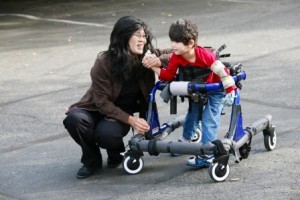 Are you working with a very young child who has multiple disabilities? If you are looking for resources, check out our new Multiple Disabilities topic page on the VA EIPD Center site! You’ll find free articles, fact sheets, a resource landing pad (PDF, New Window), a video of a mother telling her early intervention story, and links to other sites.
Are you working with a very young child who has multiple disabilities? If you are looking for resources, check out our new Multiple Disabilities topic page on the VA EIPD Center site! You’ll find free articles, fact sheets, a resource landing pad (PDF, New Window), a video of a mother telling her early intervention story, and links to other sites.
Here are a few tips to keep in mind when working with the family of an infant or toddler with multiple disabilities.
Identify the child’s abilities first
When you first meet the child and parent, ask about the child’s abilities – what he can do, what he enjoys, how he communicates and plays with others. Find out about the child’s vision and hearing, his motor abilities, and his temperament. Observe the child and parent interacting and talk about the strengths you see.
Find out about where/how the child spends his day
Learn about what positions the child likes/doesn’t like and where he sits or lies during the day. Good positioning is essential for interaction and play, communication, development of head control, successful feeding, etc. Sometimes figuring out the best positioning is a good place to begin.
Play early cause & effect games
Using as little support as is necessary for the child to be successful, help the child learn to activate toys (shake rattles, hit a button for music, etc.). Use hand-over-hand support when necessary and fade it out as the child is able to do for himself. Learning to activate can help prepare the child for using a communication system later on, if needed. It also helps the child learn to entertain himself, exercise his brain and body, and have fun.
Watch for and read the child’s cues
When giving the child the opportunity to take his turn or respond to communication, observe his whole body for a response. He might raise one arm, wiggle a foot, move his mouth or eyes, or make a sound. Take whatever response you notice and reward it so that he learns to use his body to communicate.
Talk to the child and assume that he understands
Talk to the child throughout the day about what you are doing, what he’s doing, what’s going on around him. Assume that he understands. Be mindful of setting expectations that can be too high and frustrating, but try to assume that the child understands and wants to respond or participate to help him build his abilities to do just that.
Always ask first
Before moving the child, dressing or changing his diaper, offering him something to eat, or helping him play, always ask him if it is okay or tel him what’s about to happen first and wait for his response. If he doesn’t give a clear reply, do your best to accommodate what you think he wants. Children with multiple disabilities often have much done to them; by asking them first, you give them some control and an opportunity to participate in what is happening.
Help the child actively participate
Help the child’s family find ways for the child to actively participate in whatever everyone else is doing. It’s easy for a child with multiple disabilities to only “participate” by being moved to the location to watch, but this isn’t really participating. Help caregivers, siblings and peers learn to help the child join the fun by helping him use his hands to play, offering him similar materials he can use, reading his responses, helping him take a turn, etc.
Do you have a good suggestion for how intervention providers and caregivers can help children with multiple disabilities actively participate? Or maybe you have an idea to share about how to learn about a child’s abilities? Share your thoughts in the comments below!


